Click here to print
CLIR Helps Preserve Collections at Risk
posted October 13, 2018
Thanks to grants from the nonprofit Council on Library and Information Resources, film of key events in late-1960s political life, footage of Native American song and ceremony, and audiovisual records of diasporic Jewish life around the world are to be preserved.
Those films are among the collections of audiovisual content of high scholarly value that have recently received financial support as part of the CLIR’s Recordings at Risk grant program.
Since the first grants in 2017 the program, which is funded by The Andrew W. Mellon Foundation, has awarded $2.3 million to libraries that are digitizing and making publicly accessible a wide variety of at-risk audiovisual and audio collections.
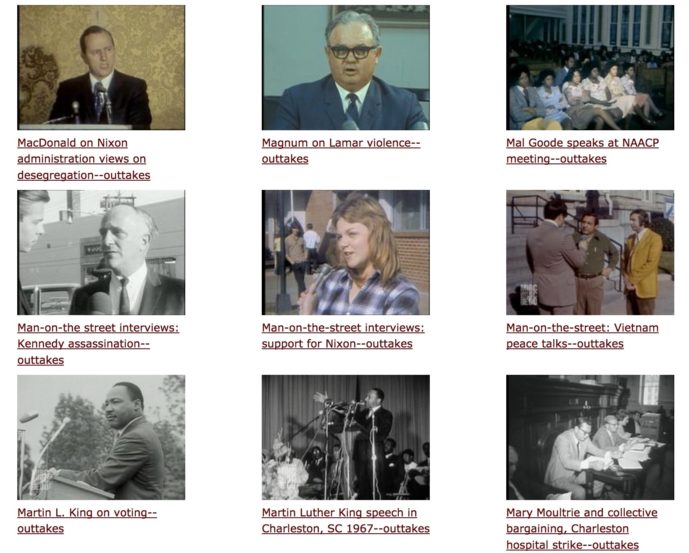
A selection of films being preserved by one of the grant recipients, the University of South Carolina, in its project, Preserving Two Watershed Years of Outtakes from the WIS-TV News Collection, 1968-1969.
The range and nature of the collections, and the relatively modest amounts that the recipient institutions are using to pursue their restoration work, underscore one sometimes-forgotten reality of audiovisual preservation work: that it is often a matter of small increments of work, each of which is a major undertaking for individual organizations involved.
Among recipients in the most recent (Fall 2018) round of awards with moving-image collections to preserve (grants also go to audio collections), were:
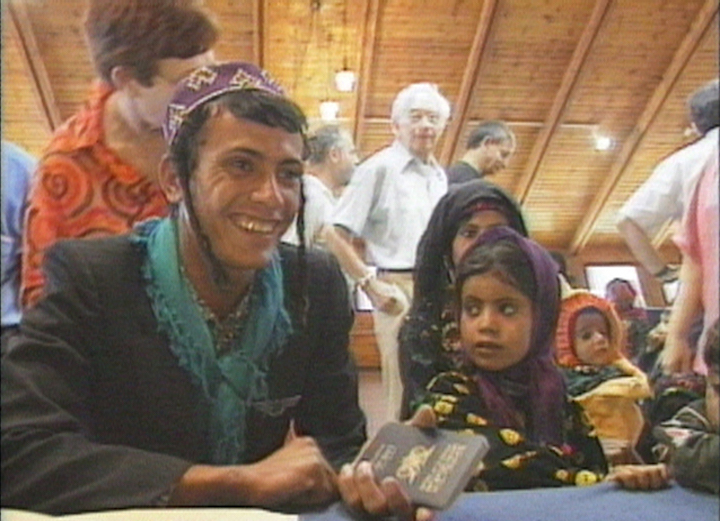 American Jewish Joint Distribution Committee, Inc.: In its project Communities-At-Risk: An Audio-Visual History of Jewish Communities in Transition, this leading Jewish humanitarian organization is preserving almost 150 historic films, videos, and long-playing records that depict its work with communities-at-risk during historic transitions. Among those: post-World War II displaced persons in Germany and Italy; North African immigrants to France (1960s) and Israel (1970s); post-Communist Jewish communities from Cuba to Ukraine (1990s); relief work in Ethiopia, Syria, and Yemen (1990s); and JDC’s relief responses to the Rwandan genocide, the Armenian earthquake, and the Balkan wars. ($30,798)
American Jewish Joint Distribution Committee, Inc.: In its project Communities-At-Risk: An Audio-Visual History of Jewish Communities in Transition, this leading Jewish humanitarian organization is preserving almost 150 historic films, videos, and long-playing records that depict its work with communities-at-risk during historic transitions. Among those: post-World War II displaced persons in Germany and Italy; North African immigrants to France (1960s) and Israel (1970s); post-Communist Jewish communities from Cuba to Ukraine (1990s); relief work in Ethiopia, Syria, and Yemen (1990s); and JDC’s relief responses to the Rwandan genocide, the Armenian earthquake, and the Balkan wars. ($30,798)
The Art Institute of Chicago: In its projects Preserving Historic SAIC Lectures: Stan Brakhage (1970-1976), and The Visiting Artists Program (1977-1996), the Art Institute is preserving records relating to experimental filmmaker and film theorist Stan Brakhage, among other holdings. The collection includes 82 recordings of Brakhage’s classroom lectures (1970–1976). Age, format, and machine obsolescence require that the tapes be digitized for preservation and continued access. ($16,560)
Autry Museum of the American West: Among the many recordings and kinds of recordings dating from 1898 to 2007 in its Digitizing A Century of Native Voice and Song at the Autry Museum project, the Autry has videos of theatre productions by Native Voices at the Autry, the only Equity theatre company in the US dedicated to producing new works by Native American playwrights. Among the Autry’s preservation goals is to support tribal groups’ language and cultural revitalization efforts. ($31,742)
The Jewish Theological Seminary: In its project, Disappearing Jewish Cultures and Traditions of the Non-Western World: Digitizing Film Footage and Audio Recordings from the Johanna L. Spector Papers and Audio-Visual Materials, the seminary is digitizing moving-image and audio recordings from the Spector collection, which documents disappearing musical and communal traditions of several non-Western Jewish cultures that have survived over the last 2,000 years in India, Yemen, Azerbaijan, Egypt, Armenia, and other regions in the Middle East and India. In its application, JTS said: “The footage and audio, recorded from 1960 to 1989 during the making of [Spector’s] ethnographic documentaries, are a treasure trove of unused footage that sheds light on the religious ceremonies and traditions of vanishing cultures before dispersal from their native lands, such as the Cochin Jews of India, Yemenite Jews, and the nearly extinct Samaritans of Israel.” ($45,943)
Media Mobilizing Project: The Media Mobilizing Project Social Movement Video Collection 2002-2011, a community organization in Philadelphia, is preserving 500 mini-DV tapes documenting social movement activism — immigrant communities, unions, youth organizations, and other citizen groups —in Philadelphia and nationwide between 2002 and 2011. The mini-DV tapes in the collection were filmed by volunteer citizen journalists and is endangered by recording-media deterioration. ($28,750)
New Museum of Contemporary Art: In its project Critical Dialogue and Public Engagement in Contemporary Art, 1979–2000: Reformatting Analog Audiovisual Recordings in the New Museum Archives, the New Museum is digitizing 125 at-risk analog audiovisual recordings of symposia, artist interviews, curator talks, performances, and youth programs dating 1978–2000. The New Museum has long presented contemporary art within critical and historical frameworks for use in its programming and scholarship initiatives. It will make the records available on the Digital Archive, its open digital repository. ($17,100)
UC Berkeley Art Museum and Pacific Film Archive (BAMPFA): In its project, Saving Film Exhibition History: Digitizing Recordings of Guest Speakers at the Pacific Film Archive, 1976 to 1986, BAMPFA has, in conjunction with its renowned film-exhibition program, recorded guest speakers in its film theater: in-person presentations by acclaimed directors, including luminaries of global cinema, groundbreaking independent filmmakers, documentarians, avant-garde artists, and leaders in academic and popular film criticism. Until 2006, BAMPFA recorded speakers on consumer audio cassettes; it will digitize 750 of the earliest recordings — those at greatest risk — and make them accessible. ($45,882)
University of Houston Libraries: In its Preserving KUHT Early Educational Films project (below), the library is digitizing (by outsourcing) 118 16mm films from KUHT-TV, which began broadcasting in 1953 under one of the country’s first educational non-profit licenses. The films, some made for local audiences, others for national distribution, capture a moment in the history of distance education and of Houston. ($23,500)
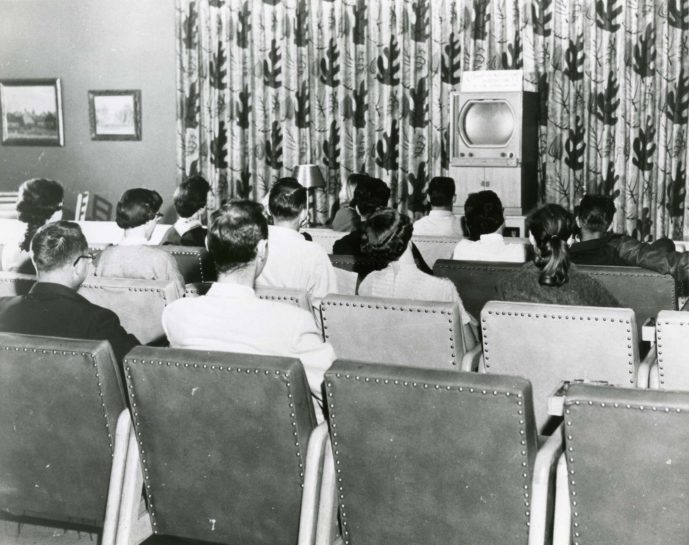
Above, an audience awaits the start of a telecourse, 1950s; below, Dr. H. Burr Roney films a demonstration for his telecourse in Biology, 1953. Images: University of Houston Libraries.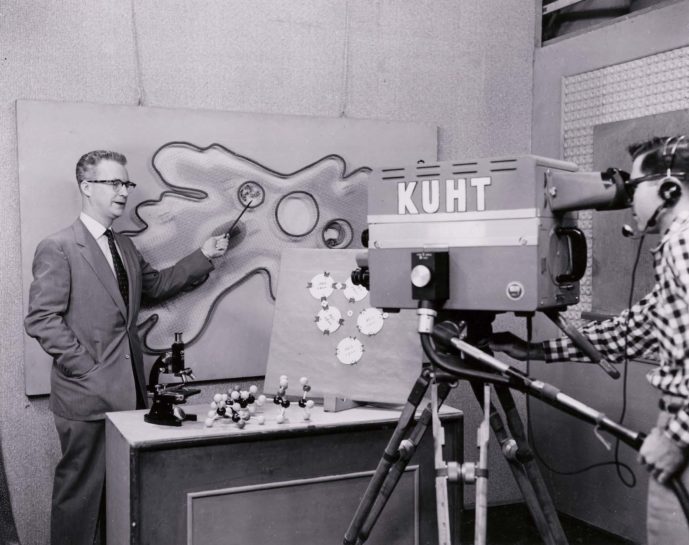
University of South Carolina’s project, Preserving Two Watershed Years of Outtakes from the WIS-TV News Collection, 1968-1969, is digitizing 170-210 deteriorating reels of 16mm television news outtakes from MIRC’s WIS-TV News Collection. The material includes coverage of events related to the civil rights movement, the assassinations of Martin Luther King, Jr. and Robert Kennedy, local and national politics, student activism, labor strikes, and the Vietnam War. The collection contains approximately 1,000,000 ft of 16 mm motion picture film from ca.1958 to 1980 documenting the political and cultural history of South Carolina. Paper holdings include teleprompter scripts for 1963 through 1979. Portions of the collection may be viewed online. ($50,000)
The University of Utah Marriott Library: For its project, Regional Voices in a Time of National Change: Preserving and Providing Access to KUTV News Broadcasts January 1977-March 1979, will digitize recordings that the Salt Lake City television station KUTV-2 made of its nightly news reports. The recordings were made off-air onto U-matic videocassette, a format now obsolete and prone to degradation. With its grant, the Marriott Library proposes to return these broadcasts to the public eye by digitizing the endangered earliest 250 recorded airchecks. The recordings provide local perspectives on such national issues as racial and gender equality and capital punishment. ($20,500)
Walker Art Center: The arts presenting organization will digitize 135 recordings of artistic presentations from 1953 to 2006 in its project, Digitizing At-Risk Walker Art Center Sound and Moving Image Collection recordings. The collection includes performances, interviews, and dialogues with internationally recognized artists in a variety of fields including painting, sculpture, dance, literature, film, music, theater, design, and architecture. Among the interviewees captured on 3/4″ U-matic tape are visual artists David Hockney, Isamu Noguchi, Jennifer Bartlett, and Yoko Ono, and filmmakers Jean-Luc Goddard, Michael Powell, and Dusan Makavejev. Also to be preserved are performance videos by Kei Takei, Trisha Brown, David Gordon, William Burroughs, and Libby Larson. The Walker will make digitized archival resources available through its Living Collections Catalogue, which is a platform for moving-image and other media along with analytic essays. ($20,155)
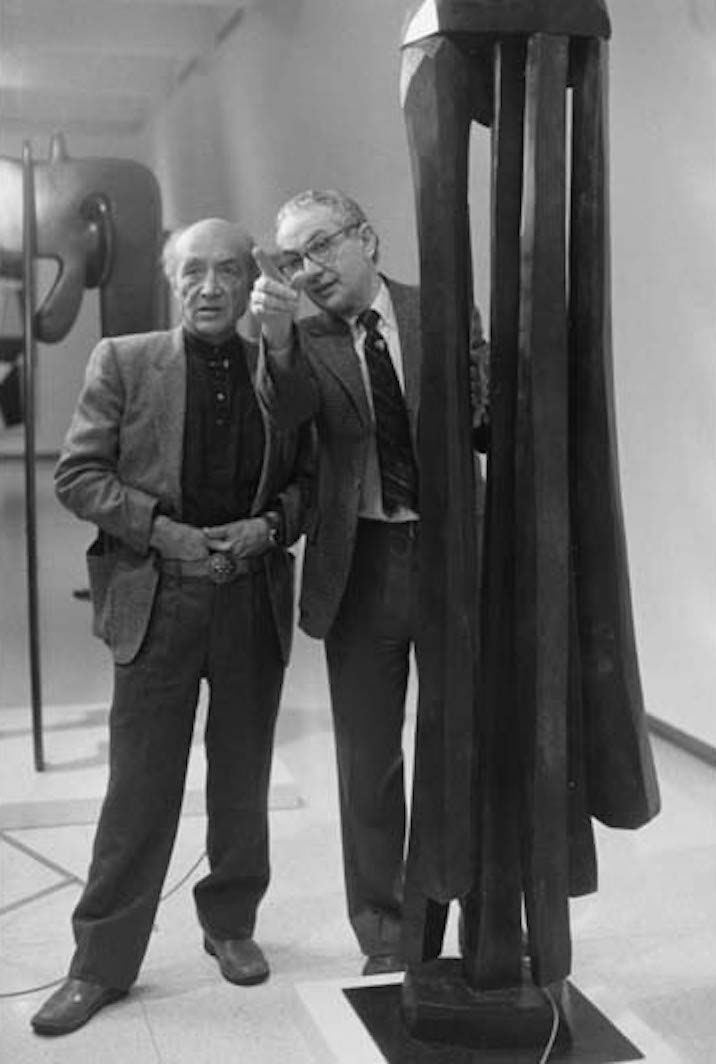
Sculptor Isamu Noguchi (left) with Martin Friedman, director of Walker Art Center during exhibition installation for “Imaginary Landscapes,” 1978. Courtesy Walker Art Center.
In earlier rounds of the CLIR’s Recordings at Risk grant program, awards relating to moving-image collections went to
African American Museum & Library at Oakland, for Preserving the Black Panther Party and Social Protest Films from the Henry J. Williams Jr. Film Collection
The Bancroft Library, for Global Influence: Preserving Moving Images from Environmental Movements in the West, 1920-2000
Franklin Furnace, for Preserving Rare Recordings of Performance Art in the Franklin Furnace Video Collection
Iowa State University Library, for Activist Farmers on Film: Preserving the Recordings of the National Farmers Organization
University of California, Davis, for Red Power and Higher Education: Preserving the Audiovisual Record of the American Indian Movement for Education and Empowerment
University of North Carolina at Charlotte, for Preserving the Harvey B. Gantt 1996 Senate Campaign Recordings
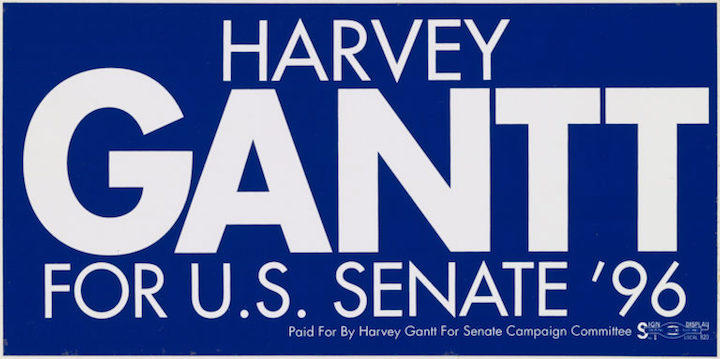 Denver Public Library, for Preserving the History of World War II’s Elite Ski Troopers, the 10th Mountain Division
Denver Public Library, for Preserving the History of World War II’s Elite Ski Troopers, the 10th Mountain Division
Swarthmore College Peace Collection, for Debating the Vietnam War: Film and Audio Recordings from the 1960s and 1970s
Last updated (with additional photos) 17 October 2018
Printed from Moving Image Archive News: http://www.movingimagearchivenews.org
URL to article: http://www.movingimagearchivenews.org/clir-helps-preserve-collections-at-risk/
Click here to print